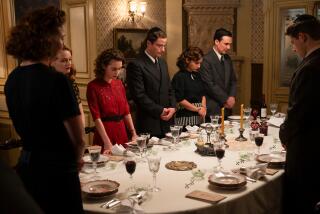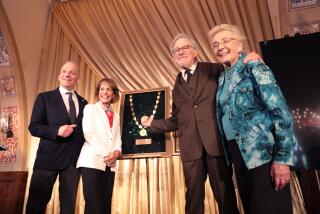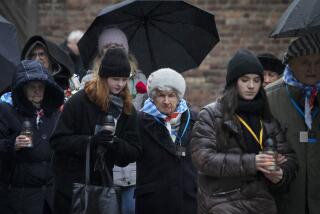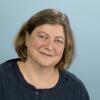Documenting a dark chapter in history one voice at a time

In an interview in her Laguna Hills home in 1996, Lotte Hoffman spoke of Kristallnacht and of the need for love to triumph over hate. Her husband Nathaniel, who died in 2009, joined her at the end of the interview.
They started by videotaping one Holocaust survivor’s story. Then came another and another.
Nearly 20 years have passed, and the stories have added up — to almost 52,000 eyewitness accounts collected all over the world.
Each month, the USC Shoah Foundation gives a public tour to talk about the collection and how it is being used. People gather in the lobby, where a collage of faces stripes the walls beneath the words: “Every survivor has a story to tell.”
On a recent morning, an elegant 91-year-old woman sat on a couch beneath that message, waiting for the tour to begin.
Lotte Hoffman said she had come to learn about the stories. She did not announce to the group that one of them was hers.
In 1996, Hoffman told her story for posterity — for her children and their children and their children. But, she said, she rarely speaks about her Holocaust experiences. They’re in the past. And there were so many others much worse. Her immediate family survived. They were not sent to a concentration camp.
Hers is a quiet story, Hoffman said — which, in the collection, is true.
But quiet can break your heart.
That is something the foundation understands.
::
It was sometime after dawn on Nov. 9, 1938. Hoffman was 16. The phone rang in her family home in Duesseldorf, Germany.
“Better leave…,” someone told her father, Max Goldberg, a lawyer. “In one hour, not one stone will be on another.”
It was the start of what would come to be called Kristallnacht or “Night of Broken Glass,” when Nazis stormed through Jewish homes, synagogues and stores in Germany and Austria. Thousands of Jews would be sent to concentration camps.
Hoffman’s father was hauled off to prison. She hid with her mother and her sister at a neighbor’s.
When the streets quieted, they headed home to find the oil paintings slashed, the marble statues broken. Every mirror in the house had been shattered, along with every bottle in the medicine cabinets. A large cabinet on the second floor had been flung forward, sending the family’s fine china and crystal crashing onto the landing below.
Even the pot on the stove had been smashed. The soup had spilled out. The meat was on the floor. Hoffman’s mother picked it up and rinsed it off so they would have food in the days to come.
Hoffman’s family wasn’t religious, but they were Jews. They had been targeted for that reason alone. So had the Jewish shops in the neighborhood. The beautiful synagogue nearby had been set on fire.
In her cultured and once-serene neighborhood, Hoffman said, “the pianos flew out the windows.”
::
One of the nonprofit foundation’s central aims is to reach the young.
But as the distance between then and now widens, how do you teach the Holocaust?
There is so much to learn from that time — about intolerance, about endurance, about group-think, about bravery.
Still, its horror is so huge that the first instinct often is to turn away.
Small, personal details, however, have a way of sinking in. Once heard, they are not easily forgotten.
Steven Spielberg understood that when he created the foundation in 1994. In the course of filming “Schindler’s List,” he had met many Holocaust survivors. He knew they were aging and that often their stories died with them.
He wanted others to be able to meet them as he had, to hear them tell their intimate stories.
Spielberg, who contributed millions to help launch the effort, called it a race against time to videotape as many testimonies as possible.
They now add up to more than 105,000 hours.
Imagine, the foundation’s Krystal Szabo told the tour group, if you tried to watch all the testimonies. It would take more than 12 years — without breaks to sleep or eat.
But you don’t. You zoom in, from the big to the small, from the millions dead to one who survived to tell the story.
The interviews have been indexed to make it possible to search by experience group — Jewish survivors, liberators, rescue and aid providers — or by name: person, place, concentration camp.
Szabo didn’t dwell on the enormity for this tour group, which included Hoffman and her helper, two university fundraisers and a 72-year-old man who had arrived with a shopping cart full of belongings and said he was taking every campus tour in preparation for applying to film school.
On a screen, she zoomed in closer and closer, from the endless desert to the individual grains of sand.
The archive, which recently was expanded to include eyewitnesses of genocide in Rwanda, has so many different stories, Szabo said. Any one will grab you.
::
Even before Kristallnacht, Hoffman’s non-Jewish friends had stopped calling.
Out on the street, she told her interviewer, “You walked carefully. People might spit at you and say, ‘Jew.’”
She had been forced to leave her school. One of her former teachers had visited in the middle of the night to say: “I want you to know that … we are not part of this, but there is nothing we can do.”
“And I think that was the general feeling, that people, they were unable to go against the tide, you know,” Hoffman told her interviewer, her voice cracking.
“It was happening, and anybody who spoke up put their own family in the same danger.... And I think there are very few heroes in this world that say, ‘Well to hell with that, I’m going to help these people.’”
Not long after Kristallnacht, Hoffman’s father was released from prison. A few months later, Hoffman and her sister fled to England. At a railway station, they said goodbye to their parents, unsure if they would see them again.
In Germany, Hoffman had hoped to become a pediatrician. In England, she became a nanny.
Still, her family was lucky. Parents and children eventually reunited and settled in America. But they could not resume the kind of life they had left behind.
Her father — who knew Greek and Latin and some French — could barely speak English and got a job as a hospital coatroom clerk. He was noticed enough over time to get slightly better work, arranging slides for doctors’ medical lectures. But in America, Hoffman said in her interview, he could never communicate well enough to talk to other learned men “like a person, like what he was.”
Here her voice, as it would more than once in her story, snagged like wool on a nail.
But not when she faced the camera with final words.
“Well, life is always different than what you imagine it should be and … when things go bad, you have to just pick up and make the best of it and start all over again,” she said. “And you’ll make it. It’s a good life. And hatred will take you nowhere. Love will.”
In a campus computer center where videotapes of the testimonies are being digitized, boxes of tapes lined a hallway. Faces of Holocaust survivors appeared on multiple video screens.
Hoffman was escorted into an icy-cold computer room where rows of black towers sprouted spaghetti swirls of wires.
Thousands of stories were in there. Somewhere in there was her one story.
Maybe someday someone would stumble upon it and find that it had something to say.
Follow City Beat @latimescitybeat on Twitter and at Los Angeles Times City Beat on Facebook.
More to Read
Start your day right
Sign up for Essential California for news, features and recommendations from the L.A. Times and beyond in your inbox six days a week.
You may occasionally receive promotional content from the Los Angeles Times.







